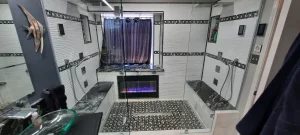In the ever-evolving modern workplace, sustainable office spaces are crucial. An often overlooked area for improvement is the office bathroom. By implementing innovative bathroom remodeling solutions, businesses can significantly reduce waste, conserve resources, and lessen their environmental impact. Embracing eco-friendly design and cutting-edge technologies not only enhances environmental credentials but also fosters healthier, more productive work environments. What does a sustainable office bathroom entail, and how can businesses achieve this transformation?
Key Takeaways
- Embracing eco-friendly bathroom design in office spaces reduces waste and carbon emissions, aligning with the demand for environmentally responsible workplaces.
- Implementing water conservation strategies, such as low-flow fixtures and greywater reuse systems, helps minimize commercial water consumption.
- Selecting sustainable materials like recycled glass and bamboo, and using low-VOC paints, reduces environmental impact and waste generation.
- Installing energy-efficient fixtures, including LED lighting and solar-powered water heaters, significantly lowers energy consumption in office bathrooms.
- Effective recycling systems, including thorough recycling programs and employee education, minimize waste generation and promote a culture of environmental responsibility.
The Case for Eco-Friendly Bathrooms
Embracing eco-friendly bathroom design is becoming an imperative in modern construction, as the environmental impact of traditional bathroom fixtures and materials continues to pose a substantial threat to the planet’s natural resources. Incorporating sustainable bathroom remodeling solutions, such as recycled materials and energy-efficient appliances, can notably reduce waste and carbon emissions, aligning with the growing demand for environmentally responsible office spaces.
Water Conservation in Commercial Spaces
Commercial water consumption, a significant contributor to the overall environmental footprint of office buildings, can be drastically reduced through the implementation of sustainable bathroom remodeling solutions that prioritize water conservation. This can be achieved through:
- Installing low-flow fixtures and greywater reuse systems
- Implementing water-efficient appliances and toilets
- Incorporating rainwater harvesting systems
- Conducting regular water audits to identify areas of improvement
Sustainable Materials for Bathrooms
Incorating sustainable materials into bathroom design is an essential aspect of reducing the environmental impact of office spaces, as traditional materials often contribute greatly to waste and pollution. Sustainable bathroom remodeling solutions can incorporate eco-friendly materials such as recycled glass, bamboo, and low-VOC paints, reducing the carbon footprint of commercial bathrooms.
Energy-Efficient Fixtures and Fittings
One important aspect of sustainable bathroom remodeling solutions is the implementation of energy-efficient fixtures and fittings, which can greatly reduce the energy consumption of office bathrooms. These innovative solutions can lower energy bills and minimize environmental impact. Some examples include:
- LED lighting with occupancy sensors
- Low-flow toilets and faucets
- Energy-efficient hand dryers
- Solar-powered water heaters
Implementing Recycling Systems Effectively
Effective implementation of recycling systems in office bathrooms can greatly reduce waste generation and promote a sustainable environment. A thorough recycling program should include clearly labeled recycling bins, regular waste audits, and employee education. By incorporating recycling systems into sustainable bathroom remodeling solutions, offices can minimize their ecological footprint and foster a culture of environmental responsibility.
Frequently Asked Questions
How Do I Measure the Sustainability of My Bathroom Remodeling Project?
To measure the sustainability of your bathroom remodeling project, assess the environmental impact of materials, water and energy efficiency, waste reduction, and indoor air quality, using metrics such as carbon footprint, water usage, and recycling rates.
Can I Reuse Existing Bathroom Fixtures in a Sustainable Remodel?
When considering a sustainable remodel, reusing existing bathroom fixtures is a viable option, reducing waste and conserving resources. Assess the condition and functionality of fixtures, and refurbish or repurpose them whenever possible to minimize environmental impact.
Are There Any Government Incentives for Sustainable Bathroom Remodeling?
Yes, various government incentives exist for sustainable bathroom remodeling, including tax credits, rebates, and low-interest loans, which can help offset the costs of eco-friendly upgrades, such as low-flow fixtures and energy-efficient lighting.
How Do I Balance Aesthetics With Sustainability in Bathroom Design?
To balance aesthetics with sustainability in bathroom design, prioritize eco-friendly materials, optimize water efficiency, and incorporate natural light, while selecting fixtures and finishes that align with your desired aesthetic, ensuring a harmonious and environmentally responsible space.
Can Sustainable Bathroom Remodeling Solutions Increase My Property Value?
Implementing sustainable bathroom remodeling solutions can indeed increase property value, as eco-friendly features, such as low-flow fixtures and recycled materials, appeal to environmentally conscious buyers and enhance a property’s marketability.
Conclusion
Commercial bathrooms play an essential role in reducing environmental impact. By adopting eco-friendly materials, energy-efficient fixtures, and water conservation strategies, businesses can minimize waste, conserve resources, and lower their carbon footprint. Effective recycling systems and employee education further enhance sustainable practices. This article examines the case for eco-friendly bathrooms, water conservation in commercial spaces, sustainable materials, energy-efficient fixtures, and effective recycling systems. Eco-friendly bathrooms are vital for reducing environmental impact in commercial spaces. By incorporating sustainable design elements, businesses can reduce waste, conserve resources, and lower their carbon footprint. This section explores the importance of eco-friendly bathrooms and their benefits for the environment.
Water conservation is essential in commercial bathrooms. Low-flow fixtures, greywater reuse systems, and water-efficient appliances reduce water consumption, minimizing the strain on municipal water supplies and conserving this valuable resource. Sustainable materials are vital for eco-friendly bathroom design. Recycled materials, low-VOC paints, and sustainably sourced fixtures reduce waste, conserve resources, and promote environmentally responsible practices.
Energy-efficient fixtures and fittings reduce energy consumption, lowering greenhouse gas emissions and conserving natural resources. LED lighting, energy-efficient HVAC systems, and power-saving appliances are essential components of sustainable bathroom design. Effective recycling systems are crucial for sustainable bathroom practices. Implementing recycling programs, composting organic waste, and reducing landfill waste promote environmentally responsible practices and minimize waste in commercial bathrooms.
In conclusion, sustainable bathroom design is essential for reducing environmental impact in commercial spaces. By adopting eco-friendly materials, energy-efficient fixtures, and water conservation strategies, businesses can minimize waste, conserve resources, and lower their carbon footprint.
You May Also Love to Read: Navigating Custom Design in the Industrial Age
